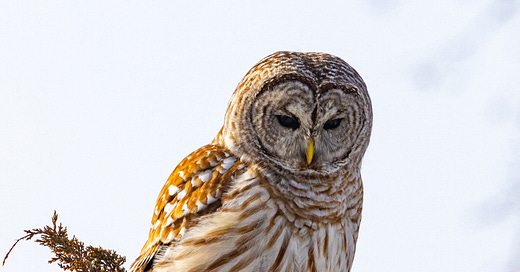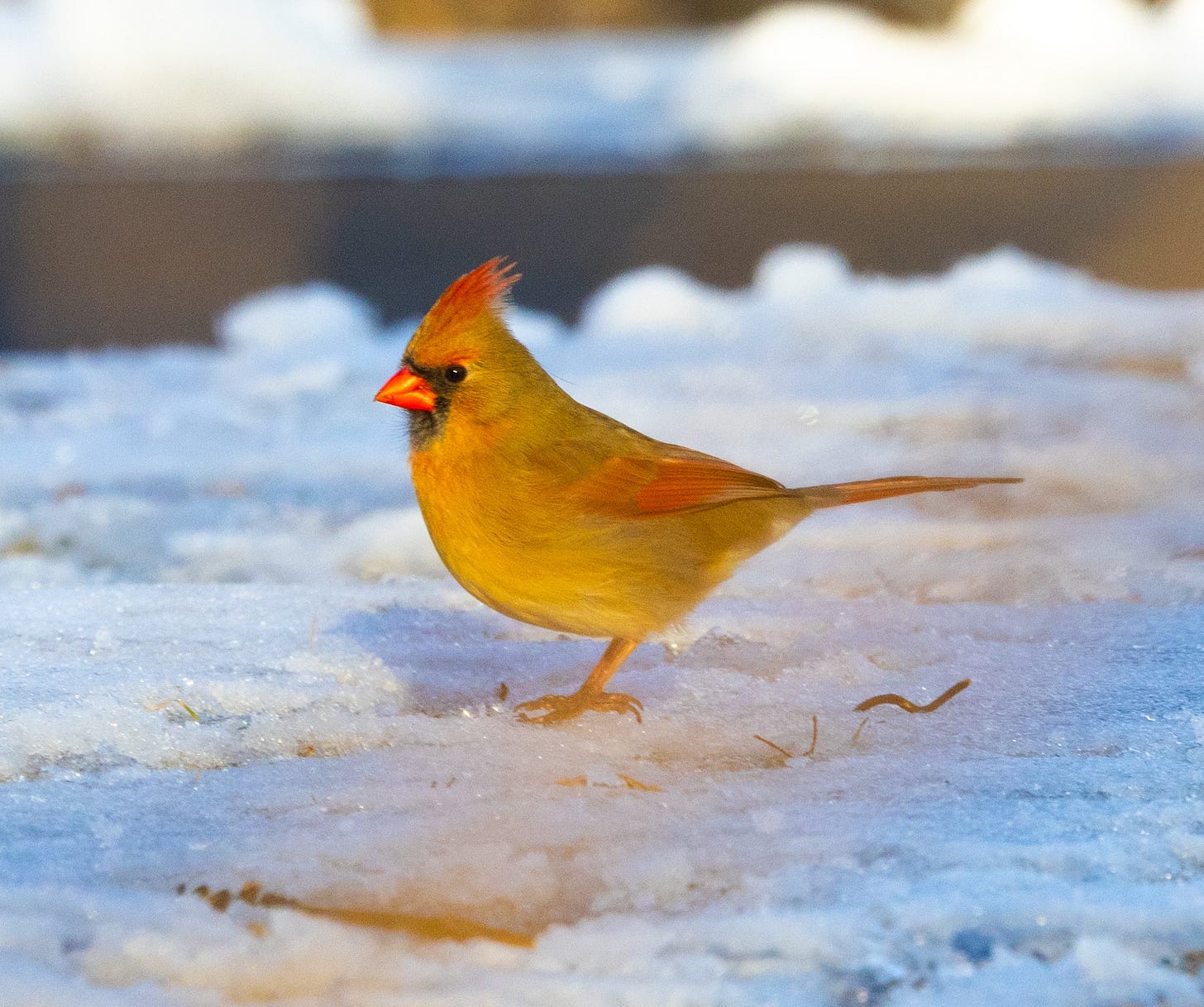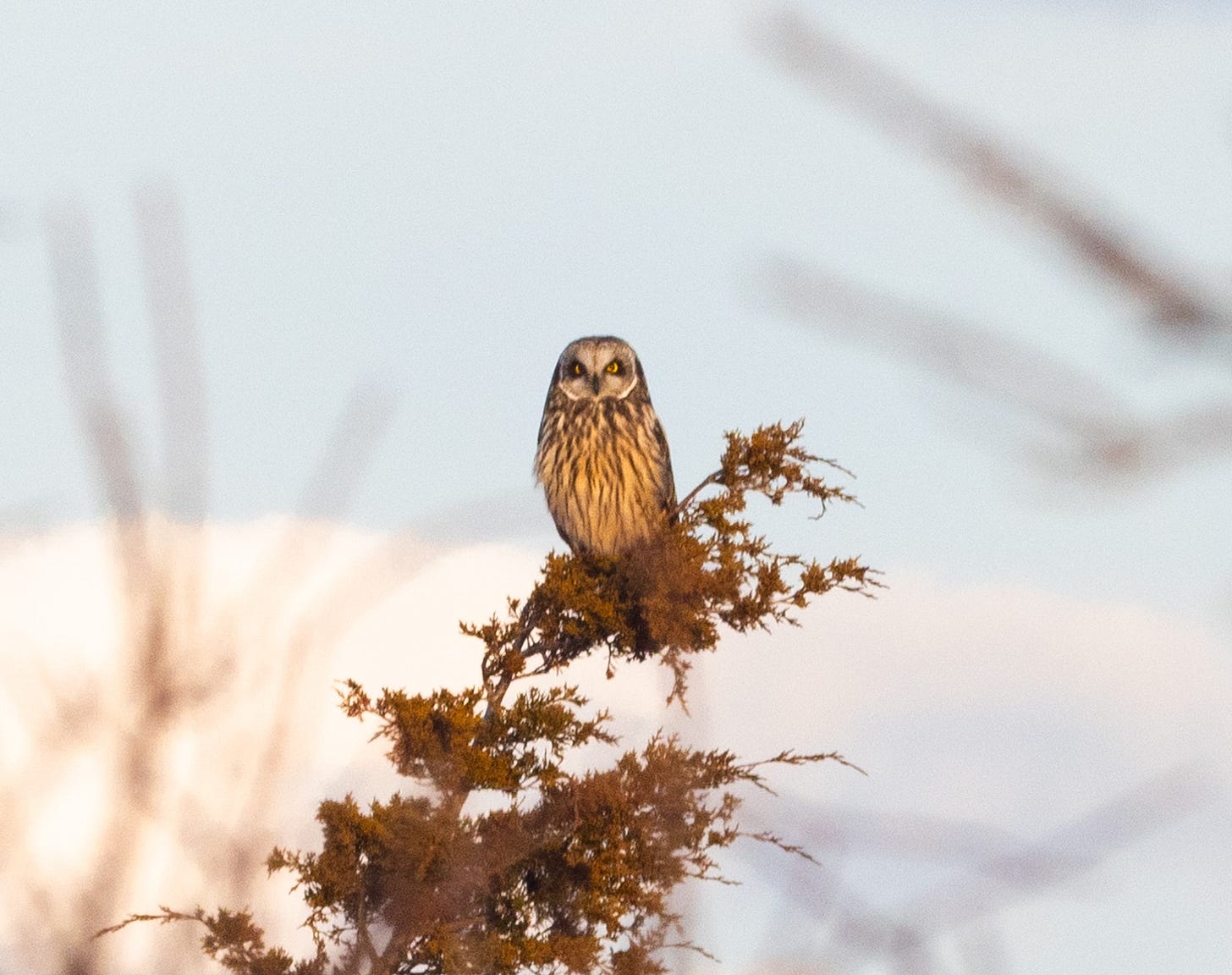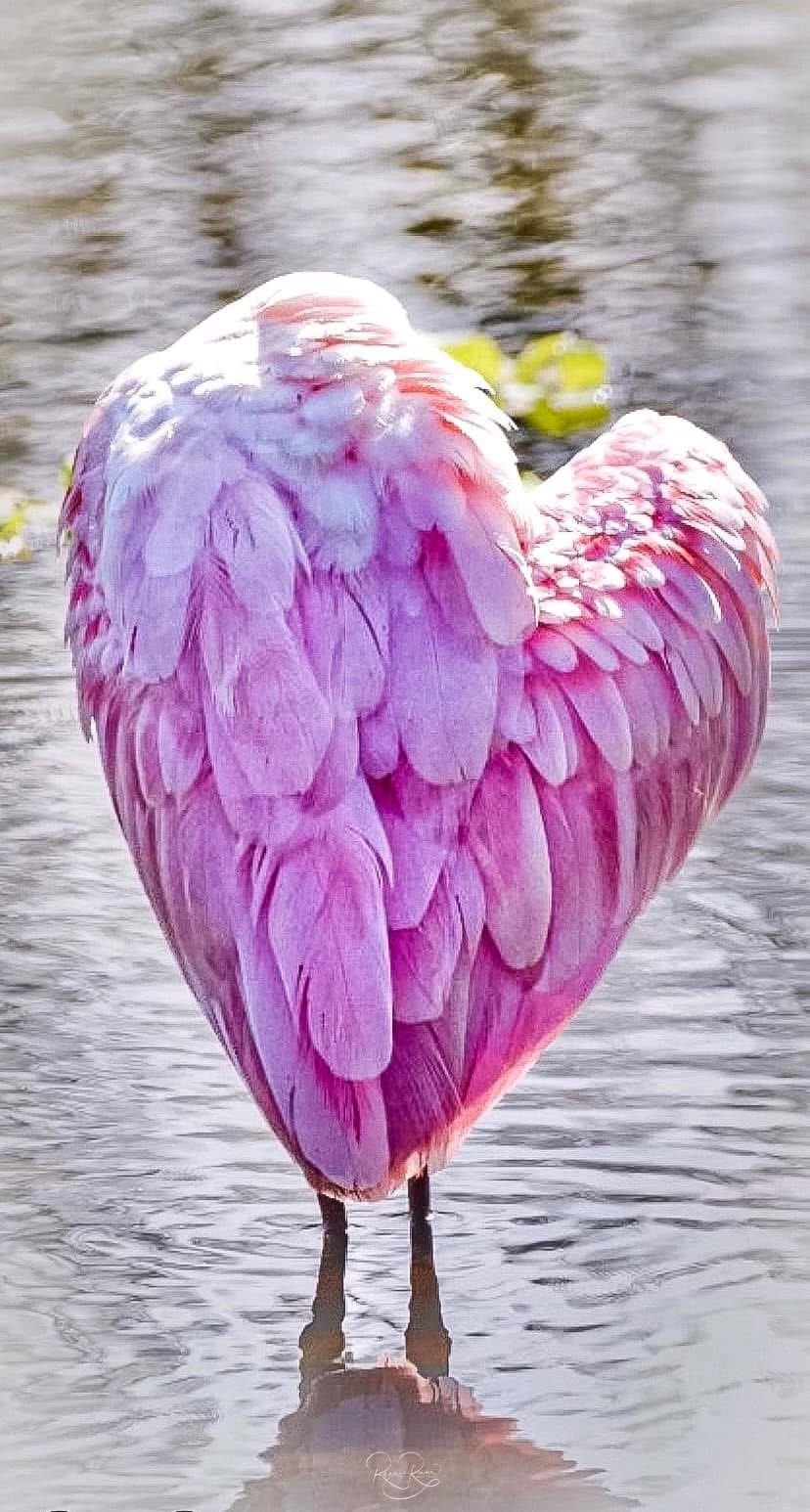1. Let's begin with a beautiful photo spread on Snowy Owls by renowned Boston Globe photographer, Stan Grossfeld: It doesn’t matter that the temperature is 19 degrees, the wind is whipping at 20 miles per hour, and the wind chill is 4 degrees. Li wants to get the Holy Grail of owl pictures: a snowy owl with its 5-foot wingspan flying in fresh snow. Li stays focused. He keeps his gloved finger on the shutter button. Hypothermia be damned. “I don’t care how cold it is, I don’t want to miss the shot,” he says. Li, who works in the medical field in Baltimore, is among those who flock to Massachusetts hoping to spot the winter visitor. Snowy owls, the largest owl in North America by body mass, travel 3,000 miles from the Arctic Circle to escape the harsh conditions of winter. (Note to federal immigration agents: They are not invading from Greenland and will return home in April.) (via The Boston Globe)
2. Whether you use eBird or not, the numbers in these "greatest checklists" are incredible: Since eBird’s launch in 2002, there have been more than 61 million U.S. checklists submitted to the community birding platform, from more than 703,000 birders. The majority of them are fairly mundane—a couple of American Robins in the backyard, maybe, or some Ring-billed Gulls in a parking lot. Some are awesome—a fun morning of spring migration or a rare bird on your favorite patch. But a small set of checklists are something else entirely: the best of the best. These are those checklists—the greatest eBird checklists in the nation. Single checklists that, in one way or another, have separated themselves from the pack and stand as truly remarkable examples of American birding. (via Audubon)
By Hap Ellis, Barred Owl - Parker River National Wildlife Refuge, Newburyport, MA.
3. Birds-of-Paradise have what some call a special "glow"; a new study suggests why: New research by scientists at the American Museum of Natural History and the University of Nebraska-Lincoln reports, for the first time, the widespread occurrence of biofluorescence in birds-of-paradise. The study, based on Museum specimens collected since the 1800s, finds biofluorescence in 37 of the 45 known birds-of-paradise species and suggests that this special "glow" is important among males for hierarchy and mating displays. The research is published today in the journal Royal Society Open Science. "It seems fitting that these flashy birds are likely signaling to each other in additional, flashy ways." said the study's lead author Rene Martin, an assistant professor at the University of Nebraska-Lincoln who conducted this work when she was a postdoctoral researcher at the Museum. (via Phys Org)
4. Feel good story of the month - with a shoutout to Riana Fisher and her students. Watch the video: It starts when we see or hear a bird in our backyard or at a local park. We then stop to listen and appreciate its beauty. As we do, we realize that the very same bird has likely been seen and admired by people in many countries, cities, and towns across the Western hemisphere during its long journey—and BAM! just like that, we have a connection to those people in Canada, Chile, Colombia, Panama, or Mexico. Students at Sacred Heart School in Washington DC are helping to protect important habitat for birds, while learning about migration and making their own connections to far away places where their families are from. This video shares their story. (via Audubon)
5. This weekend is The Great Backyard Bird Count of 2025: The Bird Count began in 1998 with around 30,000 participants in the U.S.; back then, sightings were recorded on paper and submitted by mail. It has since gone online and grown to more than 640,000 people – experienced birders and first-timers alike – reporting from around the globe. To participate, you need only to observe (or listen for) birds for at least 15 minutes during the four-day period and record your sightings using either the Merlin Bird ID or eBird app. Said Rodomsky-Bish: “It’s a relatively low bar for people to engage in a science endeavor that also happens to be really fun.” (via Cornell Chronicle)
* More color on GBBC from Country Living: If you love watching or feeding the birds in your neighborhood, the four-day Great Backyard Bird Count (GBBC) is for you! It’s a fun way to learn about the birds in your neck of the woods. But you’ll also be helping scientists track whether there are changes in bird populations and what kinds of birds live in different areas, both in the city and in the country. Happening this year on February 14 to 17, 2025, the Great Backyard Bird Count is a joint project of the Cornell Lab of Ornithology, and the National Audubon Society and Birds Canada, with support from Wild Birds Unlimited. It’s been held for more than 20 years, and events are now celebrated worldwide. Last year, more than a half-million people participated, reporting nearly 8,000 species from around the world. (via Country Living)
6. Florida in your plans this winter? Southern Living has some suggestions for birding: It’s not only snowbirds who are traveling south to warmer climates at this time of the year, but our feathered friends too. According to Audubon Florida, millions of birds fly through the Sunshine State en route to their wintering grounds, and back through when returning to their summering grounds; a considerable number of these birds come from as far away as Alaska and Argentina. A recent overnight tracking period revealed that more than 6.6 million birds crossed Florida in a 13-hour overnight period of time, from dusk to sunrise. (via Southern Living)
By Hap Ellis, Northern Cardinal - Millennium Park, Boston, MA
7. More broadly, Lonely Planet suggests 7 birding hotspots around the country: Becoming a birder is easy – all you have to do is step outside. Be it NYC's urban jungle or California's wild coast, birds are everywhere – and enjoying the winged wonders is free. According to the US Fish & Wildlife Service, roughly 45 million Americans consider themselves birders – and during the pandemic, the number of avian enthusiasts soared. In 2020, downloads of online bird-identification apps like Merlin Bird ID and the National Audubon Society's Mobile Bird Guide doubled their usual rate. Sales of birding merchandise shot up nearly 50%. Even today, the popularity of birding shows no signs of fading. (via Lonely Planet)
8. And how about India? Check out these beautiful spots (and birds): Every year, between October and March, diverse habitats across India transform into birding hotspots as more than 350 avian species from as far as the Arctic and Siberia migrate to the Indian subcontinent to escape the harsh winter of their home. As they seek refuge in warmer climes, skies over India are painted with their vibrant plumage. From the wetlands of Bharatpur to the Himalayan foothills of Sattal and the arid land of Tal Chappar to the lush Western Ghats at Koyna, India’s varied landscapes are crucial stopovers for migratory birds in the winter. So grab your binoculars and your cameras to spot raptors, owls, and a dazzling array of flycatchers, minivets, thrushes, and ducks, amongst others. Here are five birding hotspots in India to visit this winter. (via Condé Nast Traveller)
9. We love the tranquility in Gary Lee's columns from the Adirondacks (and p.s., it is always interesting to remember Adirondack State Park is larger than Yellowstone, Glacier, Everglades and Grand Cayon National Parks combined): The snow continues to fall on our landscape and in my driveway. I measured 2 feet on the dam after Friday night’s 4 inches. Friday was the only day this week that I did not blow out the driveway, thank God for snowblowers. The -20 was the coldest that I have recorded this winter, but some of the days that just got into single digits with the wind blowing were a lot colder. A few new birds that finally came to the feeder that have been feeding on yellow birch seeds were American goldfinch. On those cold mornings, there were no birds around any of the feeders, so I knew there was a predator lurking not far away. I finally got to see it — a sharp-shinned hawk who has been making a shot through every morning now. I have not seen it catch anything, but I am sure it has. I saw some feathers on the snow one morning so I’m sure he hit something. (via Adirondack Almanack)
By Hap Ellis, Short-eared Owl - Parker River National Wildlife Refuge, Newburyport, MA.
10. If you have an active feeder, it's pretty likely you'll encounter Sharp-shinned and/or Cooper's Hawks. Here's a short refresher on telling them apart: Sharp-shinned (Accipiter striatus) and Cooper’s (Astur cooperii) hawks commonly prey on feeder birds, and they are frequently reported by FeederWatchers. Despite their common occurrence, these hawks present a significant identification problem for many beginning and intermediate (and even more advanced!) birders. There is great variation in plumage and in size for these two species. Therefore, perhaps more than any other similar-looking birds, no single field mark is likely to distinguish one species from the other. Instead, the careful observer must use a combination of field marks and draw from the overall “gestalt” of the hawk for proper identification. No field guide will substitute for plenty of practice in the field. If you participate in Project FeederWatch, observed one of these two hawks during a FeederWatch count, and are not absolutely certain which hawk you observed, please report the bird as an “Sharp-shinned/Cooper’s Hawk.” (via The CornellLab Feeder Watch)
11. Speaking of hotspots, nothing like a Crimson-collared Grossbeak to bring birders to McAllen, Texas: A rare bird’s sighting at Quinta Mazatlán is bringing in birders in hopes of catching a glimpse. The birding center said Friday that a Crimson-collared Grosbeak was recently spotted. “Birders, the search continues,” Quinta Mazatlán said Saturday in a Facebook post, adding that Tom Pincelli along with others were at the center hoping to catch another glimpse of the bird. The Crimson-collared Grosbeak’s visit is considered rare due to the fact that it is native to northeastern Mexico. While its visits occur particularly in the winter, the first time it appeared in the Rio Grande Valley was in the summer. (via MyRGV)
12. Why egg prices are high: More than 912,000 birds have been impacted following the detection of the Bird Flu virus at a commercial egg production facility in Jay County in east-central Indiana, according to the Indiana State Board of Animal Health. State health officials did not identify the name of the company, nor the specific location of the facility that has been impacted with Hoosier Ag Today. This is the second largest flock size of an Indiana commercial poultry farm to be impacted by the virus, known as highly pathogenic avian influenza (HPAI) since the outbreak was first found in Indiana on a commercial turkey farm in Dubois County in February 2022. A commercial egg production facility owned and operated by Rose Acre Farms in Jackson County with 2.63 million birds was quarantined after a positive test for HPAI was identified in late January. (via Hoosier AG Today)
PPF (Photos From Friends) By Reenie Ram, Roseate Spoonbill - Sarasota, FL.
13. Moving east (well, within Australia) - an item today only because most of us might never see a Scarlet-chested Parrot: In a remote region of southeastern Australia, a group of “rare” visitors took their time passing through a wildlife sanctuary. The animals — known for being colorful yet camouflaged — “thrilled” ecologists, who spent weeks observing them. Birdwatchers and conservationists spotted a flock of scarlet-chested parrots at Scotia Wildlife Sanctuary in New South Wales, the Australian Wildlife Conservancy said in a Feb. 5 news release. A photo shows one of the scarlet-chested parrots. Its face is sapphire blue, its back is a muted green, its stomach is yellow and its namesake chest is splashed with red. Scarlet-chested parrots are known to travel long distances through the deserts of western and central Australia but are “rarely observed” in New South Wales, a state on the country’s eastern coast, the organization said. (via Miami Herald)
14. Can solar farms be managed to actually increase biodiversity? We were skeptical, but this study says otherwise: Birds across Eastern England's arable landscapes are thriving on solar farms managed with nature in mind. Research by scientists from the RSPB and University of Cambridge as part of the Center for Landscape Regeneration has found that UK solar farms managed for nature could benefit birds, including threatened species like Corn Buntings, Greenfinches, Yellowhammers, and Linnets. The UK is committed to reaching net zero by 2050, which means moving from fossil fuels to clean energy such as solar and wind. Areas of land devoted to solar farms are increasing but are sometimes assumed to be bad for nature. The new research published in the journal Bird Study, found that—hectare for hectare—solar farms situated in agriculturally dominated East Anglia contained a greater number of bird species and overall number of individuals than surrounding arable land. (via Phys Org)
15. Finally this is hilarious - definitely not your typical Valentine's Day fundraiser. Quite the opposite! Check this out: A Valentine’s Day fundraiser has taken off, but this one isn’t about honoring your sweetie, it’s about getting back at your “ex” — Bird Treatment and Learning Center (TLC) is hosting “Love Hurts,” a benefit for the nonprofit rehab center. For $10 a small bird will eat a mealworm with your ex’s name. For $100 a raptor will devour a rat named after your ex, and you’ll get a video of the event to watch it go down. Bird TLC Executive Director Laura Atwood said a few people have questioned whether the fundraiser is cruel. While sensitive to that, she said it really is meant to be in good fun, pointing out that what the birds are eating is a natural part of their diet. If anything, she said, she’s been surprised at how many people want to take part. “We’ve had donations from 38 states and several different countries; Northern Ireland, Australia, Singapore, Dubai” (via Alaska’s News Source)
Bird Videos of the Week
Video by National Geographic, “Lovebirds”.
Cornell Live Bird Cam - “lovebirds”.
Cornell Live Bird Cam - Weigh-in RoyalCam.








